Venice Travel Guide: A Guide to Venice, Italy
Welcome to our Venice travel guide! Venice, Italy is one of the most picturesque cities in the world. Known for its romantic gondola rides, beautiful architecture, and winding canals, it’s a city that many people dream about visiting. But what makes Venice such a charming and unique destination?
First and foremost, Venice is a city built on water. It’s made up of over 100 small islands connected by a network of canals and bridges. This means that there are no cars in Venice. Instead, locals and tourists alike navigate the city on foot or by boat. The lack of traffic and noise creates a tranquil atmosphere that encourages visitors to slow down and truly savour and appreciate the city’s magical beauty.
The city itself boasts a long and rich history and is jam packed full of culture. It was once a powerful city-state and was a centre of trade during the Middle Ages. Many of the city’s ornate buildings and landmarks date back several hundred years, including the famous Piazza San Marco, a large public square with an iconic basilica.
One of the most enjoyable experiences in Venice is undoubtedly taking a ride on a gondola. As you float through the canals, you’ll sail past stunning Gothic palaces, ornate bridges, and unique buildings that are only accessible by boat. Although gondola rides can be a bit pricey, they’re an essential Venetian experience that you won’t want to miss and certainly advice we woudn’t miss from our Venice travel guide.
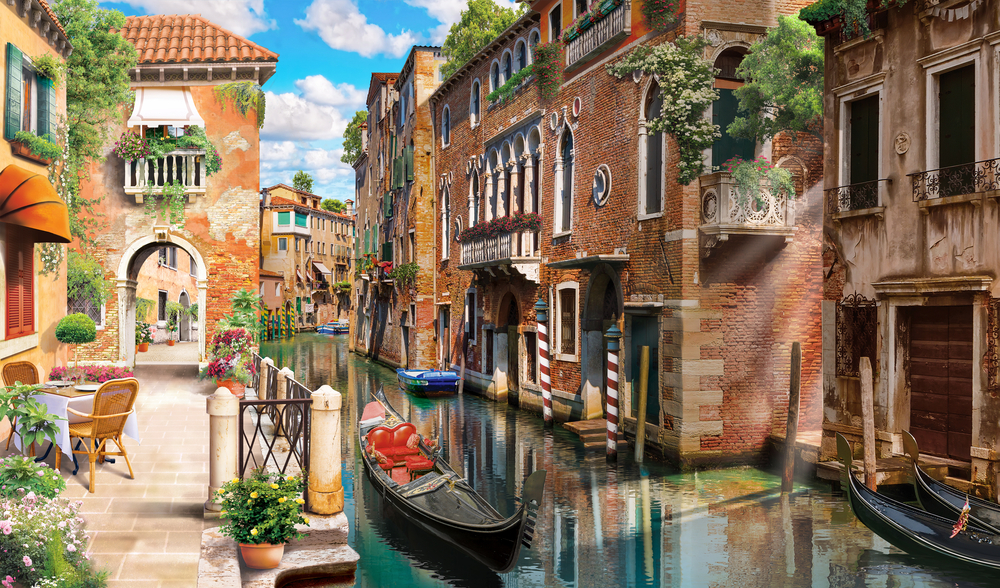
For food lovers, Venice offers some of the most delicious cuisine in Italy. Fresh seafood is obviously the highlight, with dishes such as risotto al nero di seppia (squid ink risotto) or spaghetti alle vongole (clam spaghetti) being particularly popular. Of course, with Venetian cuisine, you can’t forget about the wines to accompany these dishes. Veneto, the region in which Venice is located, produces some of Italy’s best wine, including the crisp, refreshing Prosecco.
Venice is also famous for its many festivals, including the famous Carnival of Venice. During this time, the city comes alive with colorful costumes, masks, and festivities that attract visitors from all over the world. The Venice Biennale, one of the world’s largest and most prestigious contemporary art exhibitions, also takes place in the city every two years, showcasing some of the most innovative and exciting new works of art.
In summary, Venice is a beautiful and unique city with a rich history and culture. With its winding canals, beautiful architecture, and romantic gondola, there is so much to see and do in Venice.
In this Venice travel guide, Igor Scomparin, owner of Tour Leader Venice, has kindly shared his knowledge of Venice with us. What he doesn’t know about Venice isn’t worth knowing!
What to see and do in Venice
Visit St. Mark’s Square
The Piazza San Marco is the largest and most famous square in Venice, and is surrounded by stunning architecture including the Basilica di San Marco (St. Mark’s Basilica), the Palazzo Ducale (Doge’s Palace), the Campanile (bell tower) and the Procuratie Vecchie and Nuove, which house museums and exhibition spaces. It is also called the ‘drawing room of Europe‘, due to its rich historical and cultural significance.
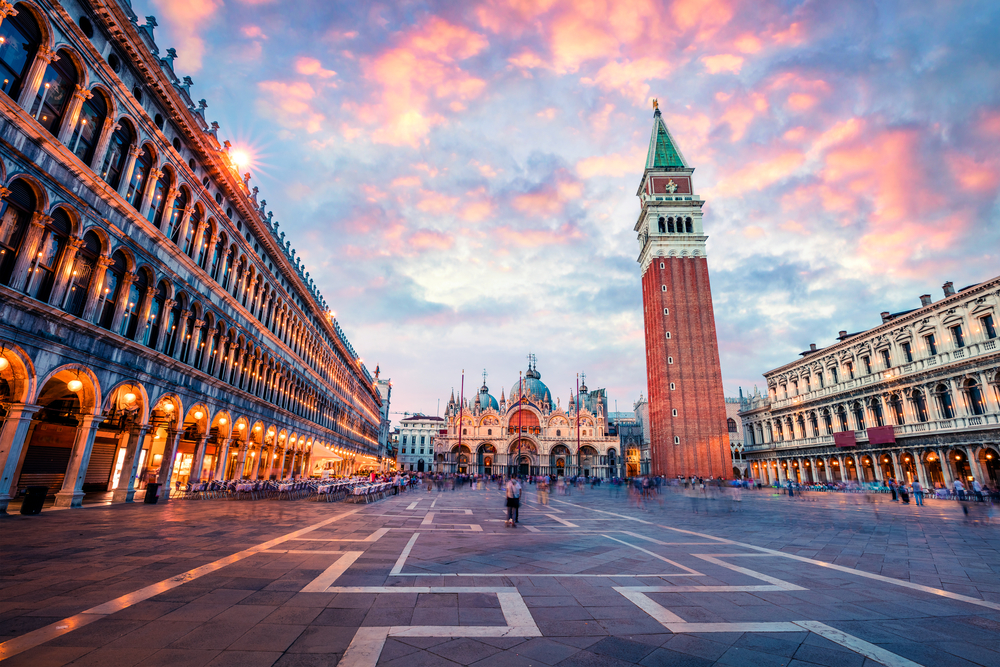
St. Mark’s Square is a popular tourist attraction, known for its picturesque setting and lively atmosphere and unmissable addition to our Venice travel guide. It is also the venue for several annual events and celebrations, such as the Venice Carnival and the Feast of the Sensa. Visitors can enjoy coffee and pastries at the historic cafes or watch the pigeons flocking around St. Mark’s Column. The square is also the departure point for gondola rides and water taxis, providing access to other parts of Venice’s labyrinthine canals.
Book skip the line tickets to St Mark’s Basilica or enjoy a guided tour of St Mark’s Basilica and the Doge’s Palace (with terrace access) at Get Your Guide.
Take a gondola ride
The gondola is a traditional, flat-bottomed Venetian rowing boat. The origins of the gondola are somewhat unclear, but it is believed that they were first used in Venice in the 11th century.
Originally, gondolas were used for transportation purposes, as they were the primary means of getting around Venice’s intricate canal system. The boats were also used to transport goods such as building materials and food. In the 16th and 17th centuries, gondolas became more ornate and were decorated with elaborate carvings and decorations. The boats were also painted black, which has now become their signature colour.
Over time, the gondola evolved into a symbol of Venice and a popular tourist attraction. Gondoliers would dress in traditional costumes and sing songs as they rowed their passengers around the canals. Taking a scenic ride through the canals to experience the charm of Venice from the water has become a must on any visit to the city.
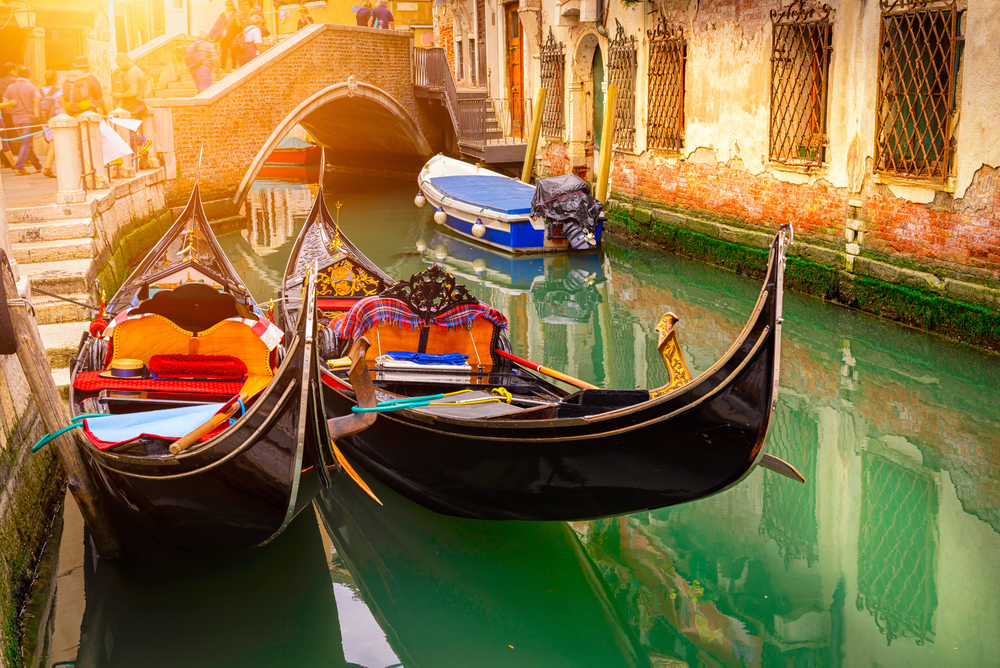
Today, there are around 400 gondolas in Venice, and they are primarily used for tourism purposes. The boats are still handcrafted using traditional techniques, and each gondola is unique.
Book a private gondola ride and skip the lines on the day or opt for a cheaper shared gondola ride on Venice’s canals instead.
Visit the Rialto Bridge
The Rialto Bridge is one of the most iconic landmarks in Venice and offers beautiful views of the Grand Canal.
The story of the Rialto Bridge dates back to the 12th century. At that time, there were no bridges across the Grand Canal, and people had to use boats to cross the waterway. However, the growing merchant trade in Venice meant that there was a need for a solid bridge that could support the weight of goods and people.
In 1181, the first wooden bridge was built across the Grand Canal. It was a simple structure that allowed boats to pass under it. However, it was not very sturdy and had to be replaced several times over the centuries.
In the 16th century, the Venetian government decided to replace the wooden bridge with a more permanent structure. They commissioned the renowned architect Antonio da Ponte to design and build a stone bridge. It took da Ponte three years to build the Rialto Bridge, which was completed in 1591.
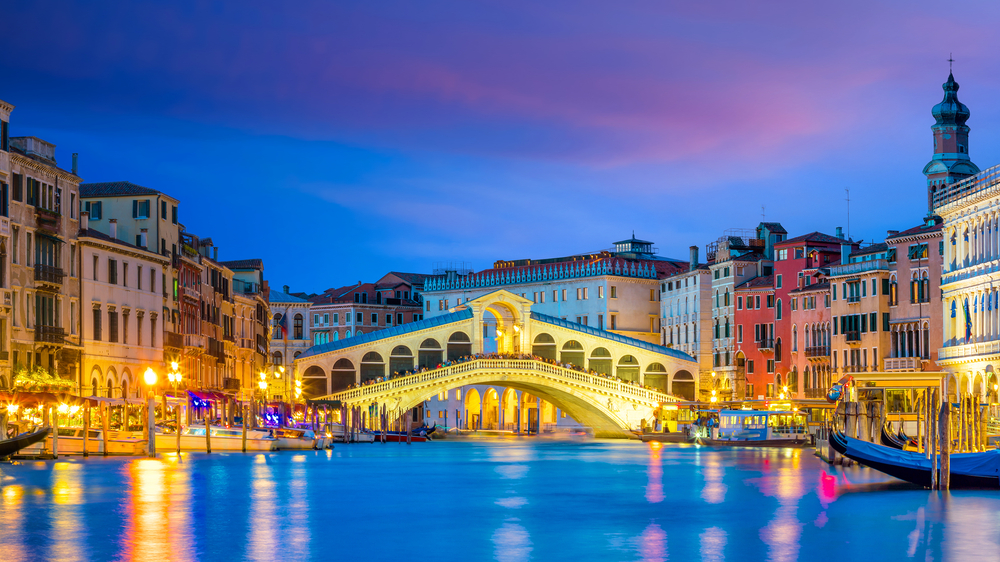
The Rialto Bridge is an architectural marvel with its graceful arches and elegant lines. It is made of Istrian stone, a type of limestone that has a warm, golden hue. The bridge is 75 feet wide and 90 feet long, and it stands on two rows of shops that sell everything from souvenirs to jewelry to fresh seafood.
Over the years, the Rialto Bridge has become an iconic symbol of Venice, attracting tourists from all over the world. It has also been the subject of many paintings, songs, and poems, reflecting Venice’s rich cultural heritage.
Today, the Rialto Bridge remains one of the most beautiful and beloved landmarks in Venice, a testament to the city’s enduring beauty and timeless charm.
See the Rialto Bridge on a private gondola ride.
Explore the art in the Accademia Gallery
This Venice art museum houses a vast collection of Venetian art, including works by Titian, Bellini, and Tintoretto.
The Accademia Museum of Venice is located in the Dorsoduro district of Venice, Italy. It is housed in the former Scuola della Carità, a 14th-century building that was converted into an art academy in 1750. The museum contains a large collection of Venetian art from the 14th to the 18th centuries, including works by famous artists such as Bellini, Titian, Tintoretto, and Veronese. Its collection includes paintings, sculptures, and other forms of visual art. It is considered one of the most important art museums in Italy and attracts thousands of visitors each year.
Visit the Peggy Guggenheim Collection
In contrast to the Accademia Museum, this is a modern art museum featuring works by some of the 20th century’s most influential artists, including Picasso, Dali, and Pollock.
The Guggenheim Museum in Venice is a contemporary art museum also located on the Grand Canal in the Dorsoduro sestiere of Venice, Italy. The museum is dedicated to the collection of modern and contemporary art belonging to the Solomon R. Guggenheim Foundation. The museum opened in 1951 and contains works by artists such as Pablo Picasso, Salvador Dalí, and Mark Rothko, among others. It is housed in the Palazzo Venier dei Leoni, an 18th-century palace that was the residence of Peggy Guggenheim, who donated her collection to the foundation.
Book Skip the Line tickets to the Peggy Guggenheim Collection.
Visit the Santa Maria della Salute Basilica
This beautiful domed church overlooks the Grand Canal and is an iconic symbol of Venice.
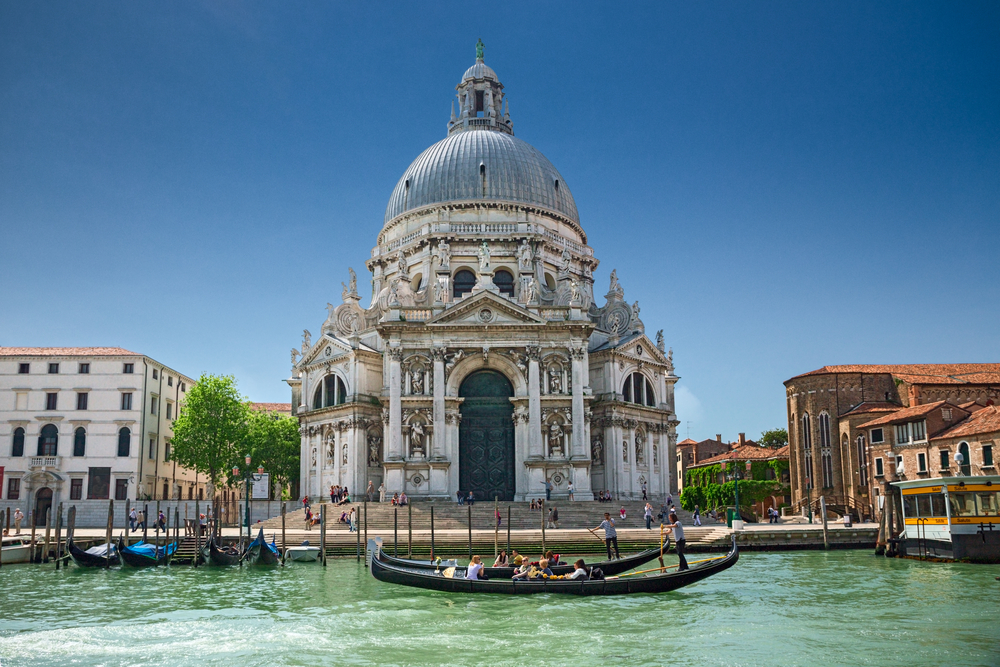
Santa Maria della Salute is a famous Roman Catholic basilica. The story of its construction dates back to 1630, when the city of Venice was hit by a devastating plague. The epidemic had spread rapidly throughout the city, claiming the lives of thousands of Venetians. In an effort to combat the disease, the Venetian government decided to build a new church dedicated to the Virgin Mary, under the name of ‘Salute‘, which means ‘health‘ in Italian.
The construction of the church was started almost immediately and quickly became a source of deep devotion for the people of Venice. The legendary architect, Baldassare Longhena, was hired to design the building. Santa Maria della Salute was constructed in the shape of an octagon with a large dome at the top, symbolising the eight-pointed star that is the emblem of the Virgin Mary.
The building was constructed on a spit of land which divided the Grand Canal and the canal of St. Mark’s, at the point where the two canals meet. The location was deliberately chosen to make the church visible from far and wide, and to show gratitude to the Virgin Mary for having saved Venice from the plague.
It took years to complete the church, and it was finally consecrated in 1681. Since then it has become a landmark of Venice and a testimony to the devotion of the Venetians towards the Virgin Mary. Every year on November 21st, the Feast of the Salute is celebrated with high mass and processions, in gratitude to the Virgin Mary for protecting the city of Venice from the plague.
Take a tour of the Doge’s Palace
This beautiful palace was once the centre of Venice’s political power, and now offers visitors a glimpse into the city’s rich history.
The Doge’s Palace, also known as the Palazzo Ducale, is a beautiful building situated in Venice, Italy. The construction of the palace began in the 9th century and was completed in the 14th century.
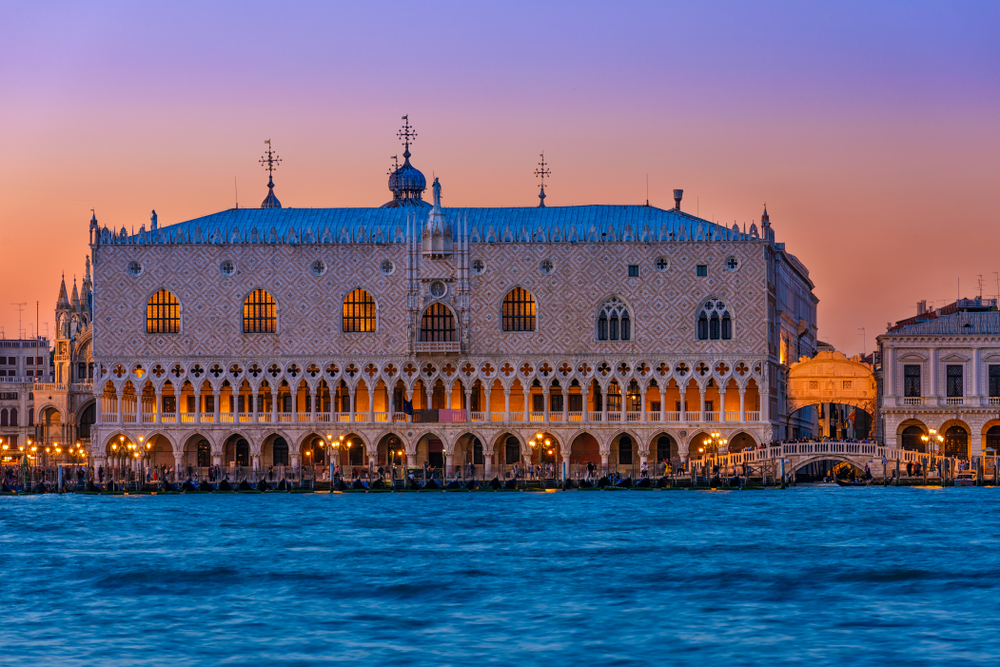
The Doge’s Palace was the residence of the Doge, who was the chief magistrate of Venice, and the headquarters of the Venetian government. It was also the home of the Great Council, which was the main decision-making body of Venice.
The palace was designed by the architect Filippo Calendario and is a stunning example of Venetian Gothic architecture. The palace is made up of several buildings that are interconnected by corridors and courtyards, and it is built around a central courtyard known as the Courtyard of the Doge.
The Doge’s Palace has a rich history, and it has been witness to many important events in Venetian history. It has been the site of lavish parties, royal receptions, and important political meetings. It is also the place where prisoners were held and where many were sentenced to death.
In addition to its historical and architectural significance, the Doge’s Palace is also home to an impressive collection of art. The palace houses numerous paintings, sculptures, and other works of art by some of the most renowned artists of the Renaissance, including Titian, Veronese, and Tintoretto.
Today, the Doge’s Palace is one of the most popular tourist attractions in Venice, attracting visitors from all over the world who come to marvel at its beauty and history. It is truly a magnificent example of the grandeur of Venetian art and architecture.
Book skip the line tickets to the Doge’s Palace.
Visit the Venetian Islands
Take a water taxi or vaporetto to the islands of Murano, Burano, or Torcello to explore the unique culture and history of these fascinating communities.
The Venetian Lagoon, located in northern Italy, is a large body of water that surrounds the city of Venice. It is divided into several smaller islands, including the islands of Murano, Burano, and Torcello.
Murano is known for its skilled glassblowers who have been creating beautiful glasswork since the 13th century. Visitors can watch demonstrations of the glassblowing process and purchase unique handcrafted glass items.

Burano is known for its colorful houses and lace-making tradition. The lace-making technique has been passed down through generations and is still highly regarded today.
Torcello is the oldest island in the Venetian Lagoon and has a rich history dating back to the Roman Empire. It is home to the 7th-century Church of Santa Maria Assunta, which features Byzantine mosaics and is considered one of the most important sites in Venice.
Visitors can explore these islands by taking a boat tour or ferry ride from Venice. Each island offers a unique experience and a glimpse into the cultural heritage of the Venetian Lagoon.
Enjoy a customised private Venice lagoon tour with Tour Leader Venice.
Attend a performance at La Fenice Opera House
The Teatro La Fenice, or simply La Fenice, is one of the most famous and important opera houses in the world, known for its beautiful architecture and stunning performances.. Located in Venice, Italy, La Fenice has a rich history dating back to the early 19th century.
The original theatre was built in 1792 but burned down in 1836 due to a fire caused by a faulty stove. The theatre was then rebuilt in 1837 and was named La Fenice, which means ‘the Phoenix‘ in Italian, because of its rebirth from the ashes.
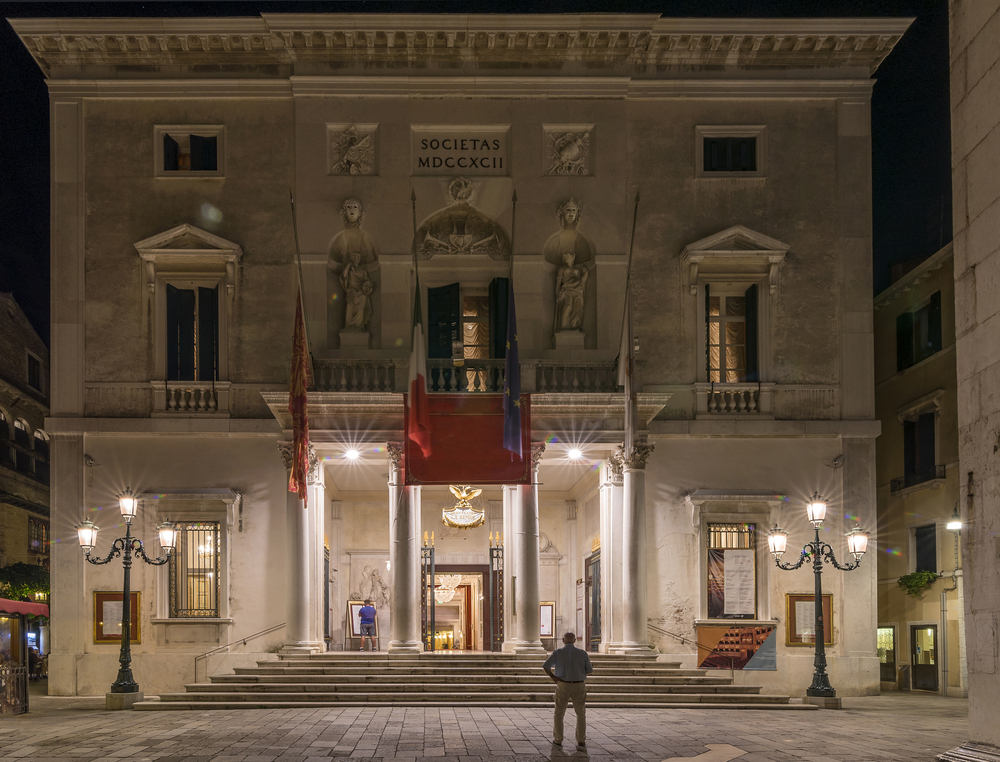
Throughout its history, La Fenice has hosted many important opera premieres and famous opera singers. The most notable operas that premiered at La Fenice include Tancredi by Gioachino Rossini (1813), Ernani by Giuseppe Verdi (1844), Rigoletto by Giuseppe Verdi (1851), La Traviata again by Giuseppe Verdi (1853), Failoni by Antonio Smareglia (1892), Rusalka by Antonín Dvořák (1901) and L’incoronazione di Poppea by Claudio Monteverdi in 1904.
La Fenice has also hosted performances by many other legendary opera singers, including Maria Callas, Luciano Pavarotti, Plácido Domingo, and José Carreras.
The opera house has gone through a number of renovations and restorations over the years, including after another devastating fire in 1996, but it remains one of the most beautiful and iconic venues for opera in the world.
Book your guided tour of La Fenice at Get Your Guide.
Must-do Tours and experiences in Venice
There are a wealth of Venice tours and experiences and we definitely suggest you opt to participate in at least one during your time in the city. For our Venice travel guide, we’ve chosen a few ideas to whet your appetite.
This is a super fun experience. At the Venice Dress Up Experience, you can try on a selection of stunning costumes inspired by the era of the great Casanova! Step into the magic of Venetian elegance and capture your beauty with a professional photoshoot so you have a souvenir to take home with you. Let your imagination run wild – pose to your heart’s content with masks , costumes and accessories. Receive a 10% discount on your experience when you use code BFYSAVE at check out.
Whilst you may think that iconic Venice is perhaps a city that needs no introduction, we highly recommend visitors invest in the services of a personal tour guide to help you best explore the hidden side of the city. No one is better placed to do this than Igor Scomparin from Tour Leader Venice. Igor will show you a fascinating side of Venice away from the millions of tourists. He’ll introduce you to some of the city’s best bars and bakeries, reveal the city’s hidden corners as well as still ticking off Venice’s most famous and unique monuments. After a few hours in Igor’s company, you’ll be far better placed to navigate and enjoy Venice on your own.
When mainland Venice feels a little too crowded, it’s worth heading out on the water to explore the Venetian lagoon. Enjoy a customised private Venice lagoon tour with Tour Leader Venice. Discover Muranois on the island of Murano, the capital of glass blowing and visit a glass blowing factory. Or discover the unique vineyard on Mazzorbo which fights for survival against Venice’s tides for 2 months out of every year. Or instead explore the colourful houses of Burano or the quiet peacefulness of the island of Torcello, which was home for Ernest Hemingway for a while. You may even be lucky enough to spot a flamingo or two here!
This is a fascinating tour of Venice’s crafts and flavours. Enjoy the chance to visit some of Venice’s most unique mask-makers or discover its artisans skilled in making handmade Venetian marionettes. Or perhaps you’d prefer to sample some of Venice’s most famous tipples and cocktails? Whatever your preference, Tour Leader Venice will organise an itinerary bespoke for you.
Discover more Venice tours and experiences with our partner company, Get Your Guide.
Best restaurants in Venice
Perhaps the most impostant part fo any Italian travel guide and certainly our Venice travel guide – food! Venice is known worldwide as one of the most romantic and beautiful cities in the world, but it is also a true foodie’s paradise. Its unique location surrounded by water and strong cultural ties to mainland Italy and to the East make up a delicious culinary tradition full of contrasts, flavours, and dishes that are worth trying. Some of the most typical dishes of Venice include:
Sarde in saor: This is one of the most typical dishes in Venetian cuisine. It is a marinated sardine dish with flavours that might sound strange to foreigners – onions, vinegar, raisins, and pine nuts. Don’t be scared though! The combination is excellent and has been around for hundreds of years, dating back to a time when Venetians needed non-perishable food for long sea voyages.
Baccalà Mantecato: Another typical dish you should try when in Venice is Baccalà Mantecato, which is made with salt-cured cod. The cod is boiled, then whipped until it becomes a cream, and that’s why this dish’s name comes from mantecare, the Italian verb meaning to mix or whip. It is served as a spread, often with crostini or polenta.
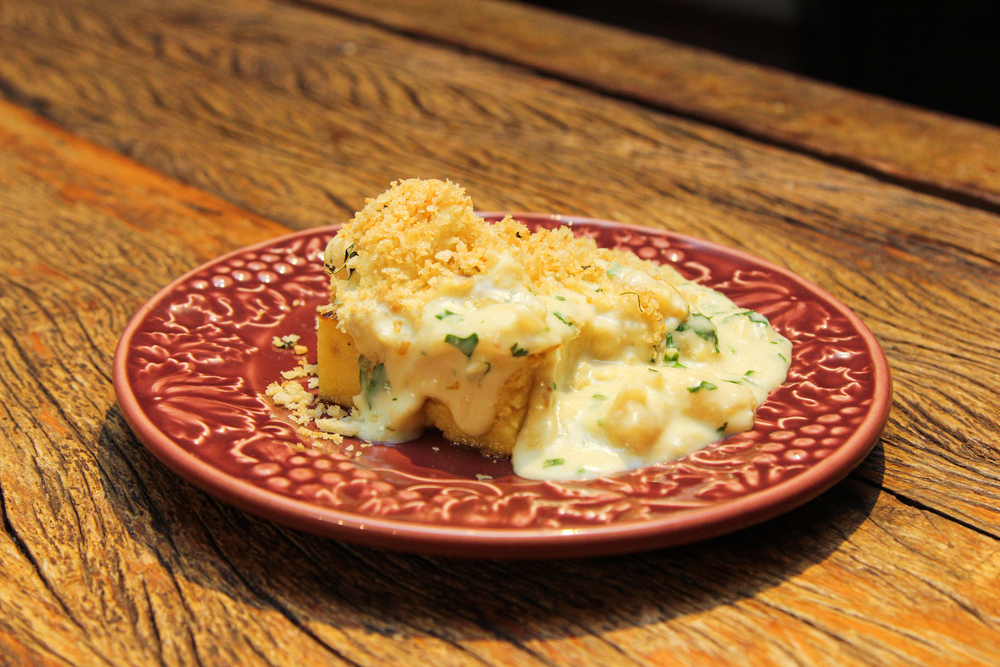
Risi e Bisi: Risi e Bisi is a traditional Venetian primo piatto or first course. It is a risotto prepared with peas from the Venetian lagoon, pancetta, and parmesan cheese. This dish is prepared in the months of April and May when the pea harvest is at its best.
Fegato alla Veneziana: Fegato alla Veneziana is another iconic dish in Venetian cuisine. It is made with veal liver cut into thin slices and is cooked with onions and white wine. This dish might be polarising for some, but it is well worth trying, and it is one of the most popular Venetian dishes worldwide.
Bigoli in Salsa: Bigoli in Salsa is a Venetian pasta dish made with wholewheat spaghetti and onions (the ‘salsa’) cooked in anchovy sauce. It is a simple and hearty dish that Venetians have been eating for generations.
Tiramisu: Another famous dessert worldwide comes from the Venice area (to be precise the city of Treviso which is 30 min from Venice).
Some of our favourite restaurants in Venice include:
Ristorante al Covo: A family run, semi-formal restaurant with a strong emphasis on excellent quality local produce and flavours.
Oliva Nera: A small, rather romantic and charming family run restaurant situated near the Piazza San Marco. Great food and great service! Closed on Wednesdays.
Antica Trattoria Poste Vecie: A beautiful restaurant inside the Rialto Venice fish market. The story goes that it was a popular haunt of Casanova who met many of his favourite ladies here!
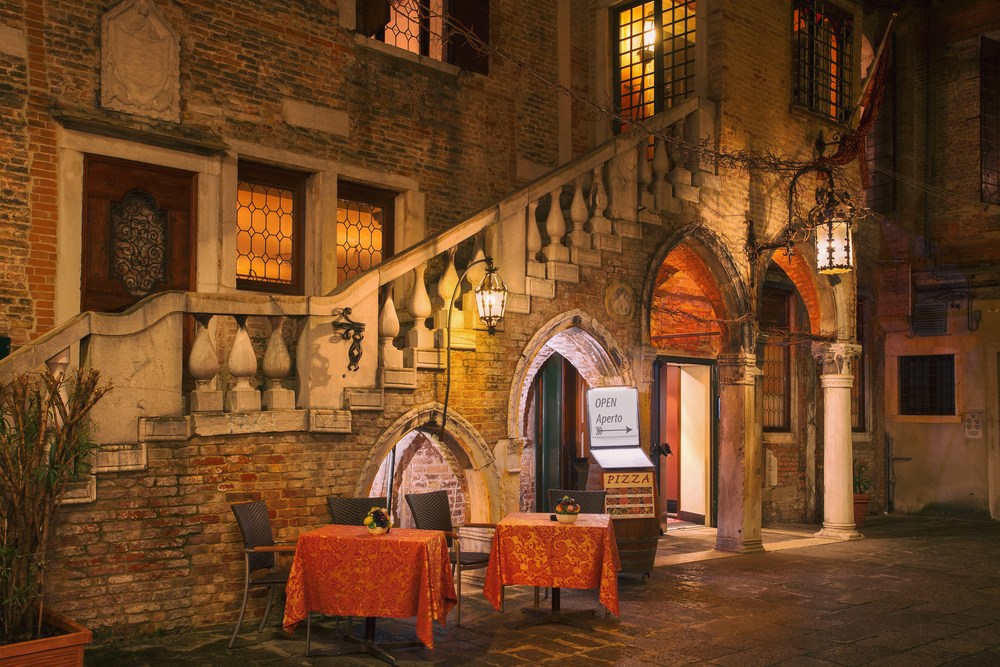
Osteria L’Orto dei Mori: Delicious cuisine served up by head chef Lorenzo Cipolla and his team who are inspired not just by the Venetian lagoon but also by Lorenzo’s homeland in the south of Italy.
Ristorante Local: A more recent restaurant, set up in 2015 by brother and sister duo Luca and Benedetta Fullin and with head chef Salvatore Sodano at the helm. It puts a modern twist on traditional Venetian dishes. The restaurant was awarded a Michelin star in 2022.
Alternatively, if you want to try creating some of these dishes for yourself, opt for a cooking experience in Venice with Tour Leader Venice.
Events in Venice
Venice offers the opportunity for visitors to participate in a host of different events all year round. As part of this Venice travel guide, we’ve chosen some of the highlights throughout the year.
Venice Carnevale
Arguably the most famous of these is the Venice Carnival, one of the most famous and colourful carnivals in the world, held annually.
The Venice Carnival is an annual festival held in Venice, Italy. It officially starts two Saturdays before Ash Wednesday and ends on Shrove Tuesday, the day before Ash Wednesday. It is known for its elaborate costumes, masks, and other festivities.
The origins of the Venice Carnival date back to the thirteenth century when the Republic of Venice was a major trading power in Europe. The carnival was a period of indulgence before the start of the Lenten season, which was traditionally a time of fasting.
During the carnival, participants would wear masks and costumes, allowing them to escape their social status and indulge in anonymous behaviors. They would attend parties, dances, and other events held throughout the city.
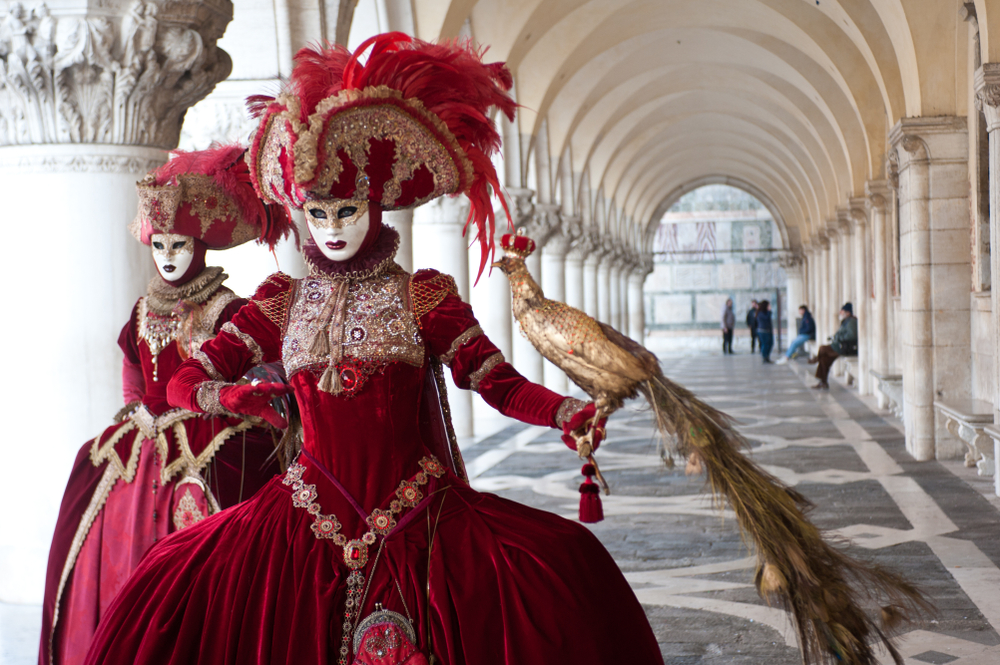
The carnival was banned in 1797 when Venice was conquered by Napoleon but was later revived in the 1970s as a way to promote tourism in the city. Today, it is a major event that attracts visitors from all over the world.
The main attraction of the Venice Carnival is the elaborate costumes and masks worn by participants. These are often handmade and can be quite intricate and detailed. There are also a variety of events held throughout the carnival, including parades, masquerade balls, and concerts.
Overall, the Venice Carnival is a unique and exciting event that celebrates the history and traditions of Venice. It is a must-visit for anyone interested in Italian culture and history.
Biennale of Art and Architecture
The Venice Biennale of Art is one of the most important contemporary art exhibitions in the world. Held every two years in Venice, Italy, it showcases a wide variety of contemporary art and artists from around the globe. Established in 1895, the Biennale includes a range of exhibitions, events, and performances across various venues in the city.
The Biennale is organized around a central theme chosen by the curator of the event. Each exhibition focuses on a different aspect of contemporary art, such as painting, sculpture, installation, video, and performance. The event attracts artists, collectors, curators, critics, and enthusiasts from around the world.
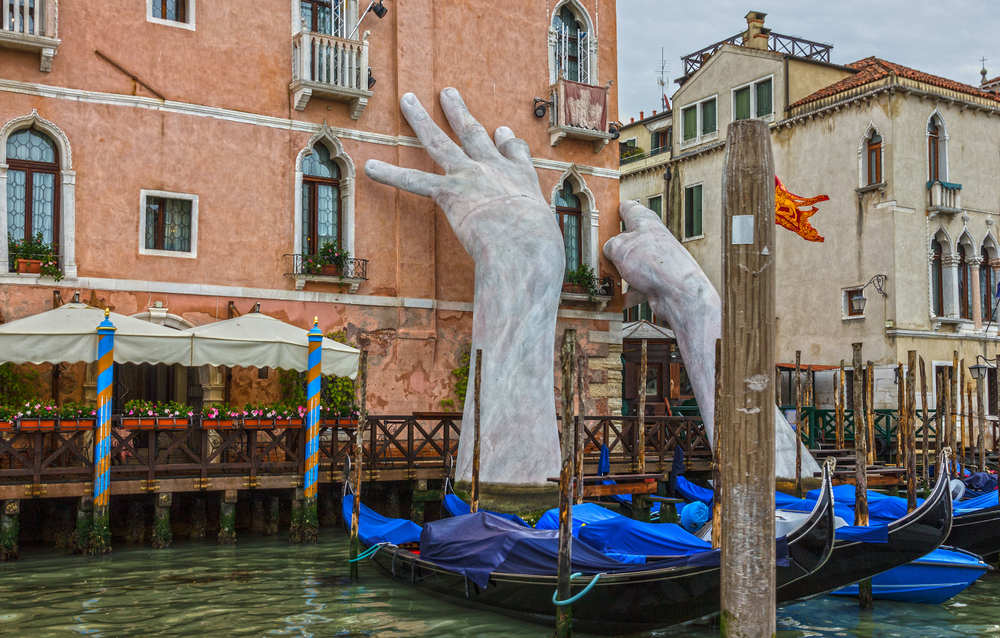
The Biennale provides a platform for artists and curators to showcase their work and engage with the wider art community. It is an important event for discovering new talent, promoting international dialogue and cultural exchange, and identifying new trends and directions in contemporary art.
The Venice Biennale of Art has played a key role in the development of contemporary art and has helped to define the direction of art in the 20th and 21st centuries.
The Festa della Sensa
The Festa della Sensa, also known as the Marriage to the Sea, is a traditional celebration that takes place in Venice, Italy, on the Sunday following the Ascension Day. It commemorates two significant events in Venetian history – the victory over the Dalmatian pirates in the 9th century and the symbolic wedding of Venice to the Adriatic Sea. It is held annually in May.
The celebration commences with a religious ceremony at the Basilica of San Marco, where the Doge (the elected leader of Venice) throws a gold ring into the sea as a sign of the city’s commitment to the sea. Following the ceremony, a procession of boats and gondolas sail to the waters around the island of San Pietro di Castello, where a similar ceremony of throwing a ring into the sea takes place.
The festival is celebrated with various cultural and sporting events, including regattas, exhibitions and concerts. It is an important event for the Venetian people, and visitors can witness the traditional pageantry and experience the city’s history and culture.
The Festa della Sensa is not just a celebration but also a reminder of the bond between Venice and the sea, which has been vital to the city’s prosperity and survival throughout its history.
Historical Regatta
This is another of the festivals of Venice that takes place on the water. It is one of the most popular events in Venice, where gondoliers compete with boats decorated in 16th-century style. It takes place on the first Sunday of September and celebrates the historic role of the Venetian Republic’s maritime heritage. The regatta features a procession of historic boats and rowing races in different categories.
The event traces its origins back to the 13th century when the Venetian Republic held water festivals to celebrate naval victories. However, the modern Historical Regatta dates back to the 19th century when the city’s mayor decided to recreate the traditional race to promote tourism.
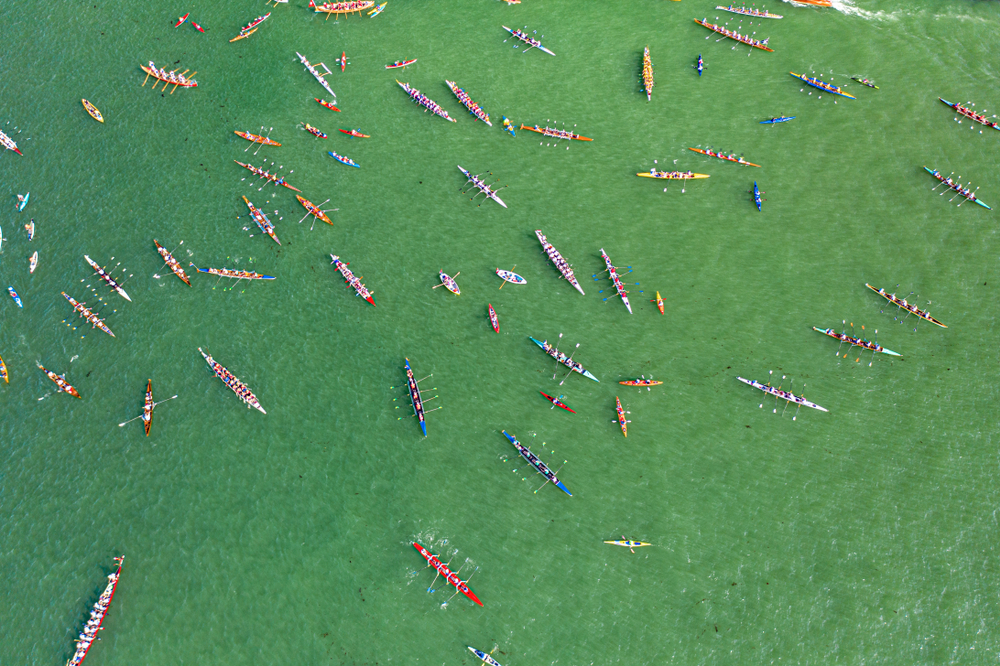
The regatta starts at the Piazza San Marco in front of the Doge’s Palace, with a colorful parade of boats floating past the grand canal. The procession includes a wide range of boats, from historical gondolas and Venetian rowing boats, which were used for fishing in the lagoon.
The rowing races are divided into various categories, including the four-oar caorline, two-oar pupparini boats, and the ceremonial parade.
The Historical Regatta is a major tourist attraction and a unique opportunity to witness Venetian maritime traditions. It is also an important cultural and historical event that celebrates the city’s rich history and longstanding maritime heritage.
Festival of the Redeemer
The Festa del Redentore (Feast of the Redeemer) is a traditional event that takes place in Venice, Italy, every year on the third Sunday of July. The festival has been celebrated in Venice since 1577 and is a religious feast dedicated to Jesus Christ as ‘Redeemer of mankind’ and was held to celebrate the end of the terrible plague that killed thousands of Venetians in the 16th century.
The centerpiece of the celebration is a temporary floating bridge that connects the Giudecca Island to the city center. The bridge, called ‘Ponte del Redentore‘, is constructed over the Giudecca Canal and is decorated with flowers and other colorful decorations.
On the evening of the third Saturday in July, Venetians light up thousands of candles all around the city, illuminating the buildings and canals with a magical light. This is called the Notte di Redentore (Night of the Redeemer) and it is one of the most evocative and romantic events in the Venetian calendar.
The celebrations culminate on Sunday with a solemn Mass held in the Church of the Redeemer, followed by a procession. The boats decorated with colourful balloons, streamers and lights are also a unique sight to see, as they make their way down the Grand Canal to the music of the traditional Le Serenate band.
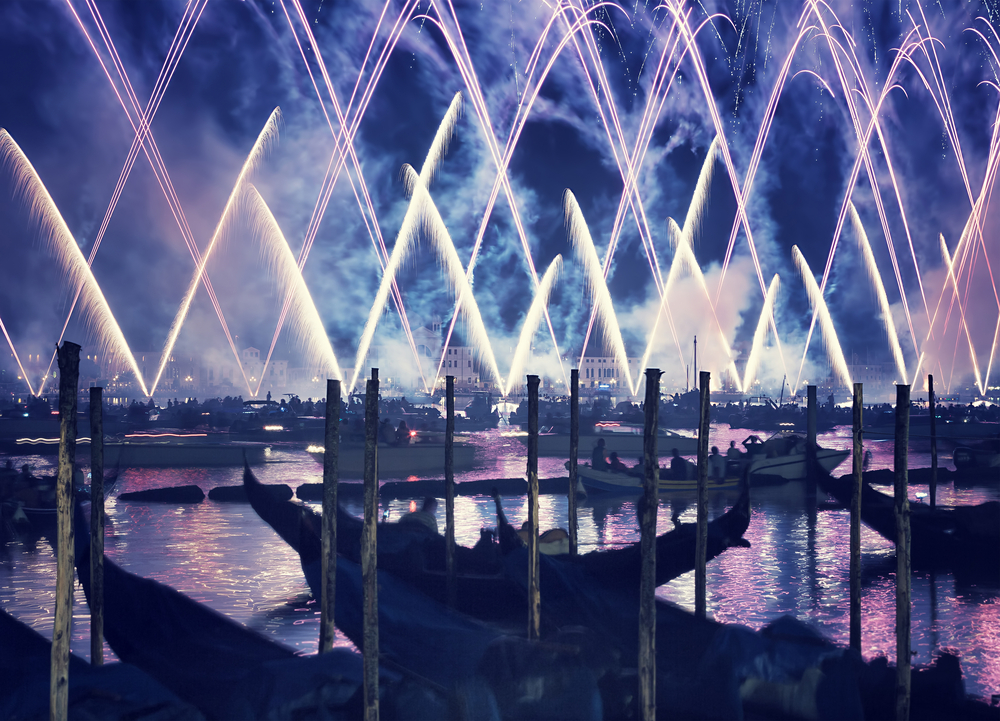
The Festa del Redentore is a true Venetian celebration, and is filled with joy, colour, music, and food. It attracts visitors from all over the world and is a must-see for anyone visiting Venice in July.
Venice International Film Festival
The Venice Film Festival, also known as the Venice International Film Festival or Mostra Internazionale d’Arte Cinematografica di Venezia, is the oldest film festival in the world. It was founded in 1932 and takes place annually in late August or early September on the island of Lido in Venice, Italy. The festival showcases a range of international films in various categories, including feature films, documentaries, and short films. It also includes award ceremonies for the best films in each category, as well as special awards for individual achievements in the film industry. Over the years, the Venice Film Festival has become one of the most prestigious film festivals in the world, with many top filmmakers, actors, and industry professionals attending each year.
Feast of the Assumption
The Feast of the Assumption, also known as Ferragosto, is one of the most important religious holidays observed in Italy. It is celebrated every August 15th to commemorate the ascension of the Virgin Mary into heaven. In Venice, this day holds a special place in the hearts of the locals, and it is celebrated with great fervour.
Vogalonga
The Vogalonga is a traditional event in Venice, Italy, which takes place every May or June, in which boats and rowers from all over the world participate in a non-competitive race through the canals of the city. The event usually takes place on the Sunday after Pentecost and has been a Venetian tradition since 1975. It was started as a way to protest against the growing use of motorized boats in the canals and to promote the use of traditional rowing boats. Participants start at St. Mark’s Square and row around the islands of the Venetian Lagoon before returning to the starting point. The event is open to all types of boats, including canoes, kayaks, and even stand-up paddleboards. The Vogalonga is not only a sporting event but also a cultural celebration of Venice’s maritime history and unique waterways.
Where to stay in Venice
For those wishing to find a hotel in Venice, we’d recommend opting to find a great value Venice hotel on Skyscanner.
How to get to Venice
By Car: Venice is located on the eastern coast of Italy, along the Adriatic Sea. If traveling by car, the easiest route is to take the A4 Autostrada, which connects Venice to cities such as Milan, Turin, and Brescia in the west, and to Trieste and further east to Slovenia and Croatia.
By Bus: There are several bus companies that offer transportation to Venice from various cities in Italy and Europe. Some of the most popular companies are Flixbus, Eurolines.
By Air: Venice has an international airport, Marco Polo Airport, which is located about 8 km from the city center. There are direct flights from major cities throughout Europe, Asia, and North America. Another option is Treviso Airport, which is about 35 km from Venice, and offers flights to and from major European cities.
By Train: Venice is well-connected by train to major cities throughout Italy and Europe. The main train station in Venice is Venezia Santa Lucia, which is located in the heart of the city. High-speed trains such as the Frecciarossa and Eurostar Italia serve Venice, making it easy to travel quickly and comfortably from major Italian cities like Rome and Milan.
By Boat: Venice is a unique city best known for its canals and waterways. Many people arrive in Venice by boat, and there are a variety of options for doing so. The most popular option is a vaporetto, which is a waterbus that operates throughout the city. Private water taxis are also available, as well as the ferries that connect the city to other destinations in the Venice Lagoon, such as Murano and Burano.
Huge thanks to Venice expert, Igor Scomparin, owner of Tour Leader Venice, for sharing his knowledge of Venice with us to create this Venice travel guide. Igor grew up in the area between Venice and Treviso and is one of the city’s most experienced tour guides.
And don’t forget to check out our top tours and experiences in Venice here.


